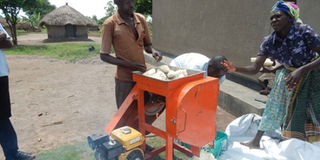Cassava production rises as farmers benefit from ethanol plant

Farmers in Alebtong District process fresh cassava before delivering it to the ethanol plant which is based in Lira Town. PHOTO BY BILL OKETCH.
A year after the establishment of an ethanol extraction factory in Lira District, farmers in northern Uganda are no longer worried about a market for their cassava.
The $1.8m (Shs6b) Kamtech Logistics plant, located at Barlwala in Adekokwok Sub-county. It is joint enterprise between Saudi, Ugandan and Lebanese investors, and became operational in 2015.
While production of cassava increased, farmers had difficulty selling their crop due to low demand, low prices and unscrupulous middlemen.
Yuventino Odemo, a farmer from Aloi Sub-county, Alebtong District, says before the factory was set up, the price of cassava was low. “A kilo of dry cassava chip was as low as Shs250. It was discouraging because we thought cassava was not profitable,” he said.
Another farmer Brenda Akello adds: “But with the factory, the price of cassava rose to Shs400, it went to Shs500 and eventually it reached Shs800 and it is still going up. Now we are able to build houses, educate our children and have a good diet.”
Generally, Uganda’s cassava production has been rising since 2010, after the country received $30m (Shs100.9b) under World Bank’s East Africa Agricultural Productivity Project (EAAPP).
Under this project, Uganda leads research on cassava and shared new technologies with Kenya, Ethiopia and Tanzania. Likewise, Kenya is leading research on dairy productivity while Tanzania is focusing on rice. Ethiopia is championing technologies to improve the productivity of wheat.
Upward trend
According to National Agricultural Research Organisation (Naro), since EAAPP was implemented, cassava production has increased from six million tonnes annually to 11.3 million tonnes. Noteworthy is that 36 per cent of Uganda’s cassava is grown in the north and 38 per cent in the east.
However, this upward trend has not been matched by a corresponding rise in demand and prices.
International Fertiliser Development Centre (IFDC), which promotes cassava growing in Lango, indicates farmers now see the ethanol plant as a good market for their produce.
A kilogramme of cassava at the Lira plant is trading at Shs900, but the price is expected to rise again, according to experts.
“Our estimation is that a kilogram of dried cassava chips would be Shs1,000, and this is very good for the farmers,” notes Ronald Lemo, IFDC regional coordinator.
“So, this factory is doing a lot in the promotion of cassava in this region. They are providing market for the farmers.”
Tobby Akecha, a director at Norah Agro Transformation—the company contracted to supply cassava to Kamtech—reveals they buying produce from farmers in Lango, Teso, Acholi, West Nile as well as some parts of Bunyoro, where production has increased rapidly over the past five years.
“When we came into the market last year, the price of dried cassava chips was Shs300 a piece. Now, a piece of fresh cassava is Shs1,500 and a bag of fresh cassava which was Shs20,000 is Shs80,000.”
Cassava was a crop that farmers sold in the villages to those who make local brews. But now they are shifting their attitude from subsistence to commercial because of good prices being offered.
Ibrahim Eitani, a director at Kamtech Logistics, told Daily Monitor extracting ethanol from cassava is also providing bio-products such as animal and chicken feed as well as aceltehyde, which is used in the production of acetic acid.
The by-products of acetic acid are used in printing processes, wood furniture and the treatment of bacterial infections.
According to Eitani, Uganda imports about a million litres of ethanol per year. The Lira plant is uses 15 tonnes of cassava daily to produce 4,000 litres a day on average (that is about 10 per cent of what Uganda imports).
While the ethanol plant can also use sorghum and maize to produce ethanol, the company opted for cassava because it is widely grown in northern Uganda.
Equally, households use the crop for food mostly, unlike maize which is highly commercialised, while production of sorghum is fairly low.




